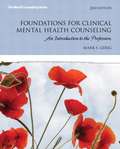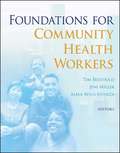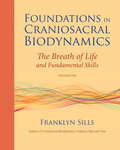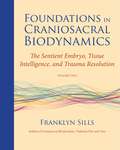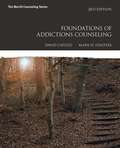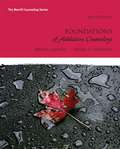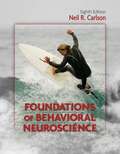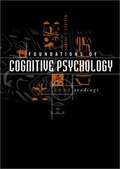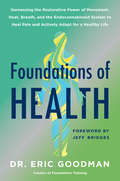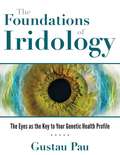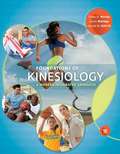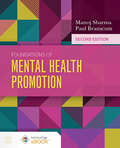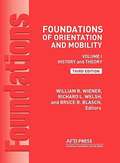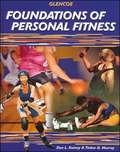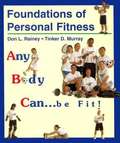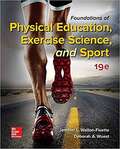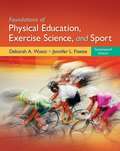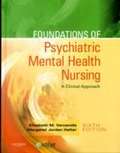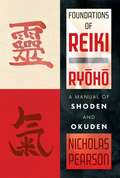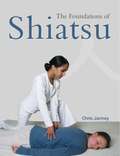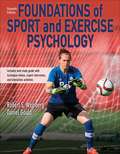- Table View
- List View
Foundations For Clinical Mental Health Counseling: An Introduction To The Profession
by Mark S. GerigIn Gerig's Foundations for Clinical Mental Health Counseling, readers get an accurate picture of the mental health counseling profession in its contemporary environment, what the author calls a "professional view from the trenches that is academically informed." Here, future mental health counselors discover a fresh, up-to-date perspective on the profession in the book's descriptions of relevant settings, public policies, and trends that show clearly how counselors can be helpful to their clients, marketable to potential employers, relevant when communicating with stakeholders or public policy makers, and, when applicable, advocates for consumers and the profession.
Foundations for Community Health Workers
by Tim Berthold Alma Avila Jennifer Miller BertholdFoundations for Community Health Workers Foundations for Community Health Workers is a training resource for client- and community-centered public health practitioners, with an emphasis on promoting health equality. Based on City College of San Francisco's CHW Certificate Program, it begins with an overview of the historic and political context informing the practice of community health workers. The second section of the book addresses core competencies for working with individual clients, such as behavior change counseling and case management, and practitioner development topics such as ethics, stress management, and conflict resolution. The book's final section covers skills for practice at the group and community levels, such as conducting health outreach and facilitating community organizing and advocacy. Praise for Foundations for Community Health Workers "This book is the first of its kind: a manual of core competencies and curricula for training community health workers. Covering topics from health inequalities to patient-centered counseling, this book is a tremendous resource for both scholars of and practitioners in the field of community-based medicine. It also marks a great step forward in any setting, rich or poor, in which it is imperative to reduce health disparities and promote genuine health and well-being. " -Paul E. Farmer, MD. , PhD, Maude and Lillian Presley Professor of Social Medicine in the Department of Global Health and Social Medicine at Harvard Medical School; founding director, Partners In Health. "This book is based on the contributions of experienced CHWs and advocates of the field. I am confident that it will serve as an inspiration for many CHW training programs. " -Yvonne Lacey, CHW, former coordinator, Black Infant Health Program, City of Berkeley Health Department; former chair, CHW Special Interest Group for the APHA. "This book masterfully integrates the knowledge, skills, and abilities required of a CHW through storytelling and real life case examples. This simple and elegant approach brings to life the intricacies of the work and espouses the spirit of the role that is so critical to eliminating disparities-a true model educational approach to emulate. " -Gayle Tang, MSN, RN. , director, National Linguistic and Cultural Programs, National Diversity, Kaiser Permanente "Finally, we have a competency-based textbook for community health worker education-well informed by seasoned CHWs themselves as well as expert contributors. " -Donald E. Proulx, CHW National Education Collaborative, University of Arizona
Foundations in Craniosacral Biodynamics, Volume One
by Franklyn Sills Dominique Degranges Michael KernBiodynamic Craniosacral Therapy (BCST) is commonly seen as the spiritual approach to craniosacral therapy (CST); in fact, BCST as taught by Franklyn Sills, the pioneer in the field, is quite different from conventional CST. Biodynamic work is based on the development of perceptual skills where the practitioner learns to become sensitive to subtle respiratory motions called primary respiration and also to the power of spontaneous healing. Through the Breath of Life, which, Sills asserts, echoes the Holy Spirit in the Judeo-Christian tradition, bodhicitta in Buddhism, and the Tai Chi in Taoism, students of BCST learn to enter a state of presence oriented to the client's inherent ability to heal.In Foundations in Craniosacral Biodynamics, Sills offers students and practitioners an in-depth, step-by-step guide to the development of perceptual and clinical skills with specific clinical exercises and explorations to help students and practitioners learn the essentials of a biodynamic approach. Individual chapters cover such topics as holism and biodynamics; mid-tide, Long Tide, Dynamic Stillness and stillpoint process; the motility of tissues and the central nervous system; transference and the shadow; shamanistic resonances; and more.From the Trade Paperback edition.
Foundations in Craniosacral Biodynamics, Volume One
by Franklyn Sills Michael Kern Dominique DegrangesBiodynamic Craniosacral Therapy (BCST) is commonly seen as the spiritual approach to craniosacral therapy (CST); in fact, BCST as taught by Franklyn Sills, the pioneer in the field, is quite different from conventional CST. Biodynamic work is based on the development of perceptual skills where the practitioner learns to become sensitive to subtle respiratory motions called primary respiration and also to the power of spontaneous healing. Through the Breath of Life, which, Sills asserts, echoes the Holy Spirit in the Judeo-Christian tradition, bodhicitta in Buddhism, and the Tai Chi in Taoism, students of BCST learn to enter a state of presence oriented to the client's inherent ability to heal.In Foundations in Craniosacral Biodynamics, Sills offers students and practitioners an in-depth, step-by-step guide to the development of perceptual and clinical skills with specific clinical exercises and explorations to help students and practitioners learn the essentials of a biodynamic approach. Individual chapters cover such topics as holism and biodynamics; mid-tide, Long Tide, Dynamic Stillness and stillpoint process; the motility of tissues and the central nervous system; transference and the shadow; shamanistic resonances; and more.From the Trade Paperback edition.
Foundations in Craniosacral Biodynamics, Volume Two: The Sentient Embryo, Tissue Intelligence, and Trauma Resolution
by Franklyn Sills Dominique Degranges Cherionna Menzam-SillsFoundations in Craniosacral Biodynamics presents a comprehensive grounding in the clinical skills needed in a biodynamic approach to craniosacral therapy. Author Franklyn Sills places particular emphasis on developing what he terms "perceptual skills," diagnostic skills that enable the practitioner to perceive the subtle sensations and intuitive insights that are the groundwork of most forms of holistic somatic therapy.The biodynamic approach has its origins in the clinical exploration of W. G. Sutherland, DO, (1873-1954), the founder of osteopathy in the cranial field and "forefather of craniosacral therapy." In the last ten years of his life, his work changed from a biomechanical approach to a fully holistic orientation toward the ordering and enlivening forces present in the human system. Sutherland described his experiences of a mysterious presence, the "Breath of Life," from which ordering forces and healing intentions arose. His work then shifted from biomechanics to biodynamics; from analysis and motion-testing to an appreciation of the unfolding of the "inherent treatment plan." Sutherland encouraged practitioners to use no outside force whatsoever, but to allow the inherent ordering forces, which he called "potency," to make the decisions and do the work.Franklyn Sills pioneered the biodynamic approach to craniosacral therapy outside the osteopathic profession. This approach has now spread around the world in various forms. Sills wrote the early books in this field, and this new book now brings the text up to date. Foundations in Craniosacral Therapy, Volume Two expands on the work described in the previous volume, starting with an overview of a biodynamic approach to craniosacral therapy, which emphasizes the suspensory nature of the human system. Here we review and deepen our understanding of the "three bodies"--the physical, fluid, and tidal bodies. We also review and expand upon the suspensory nature of the holistic shift--the physical body suspended in the fluid body, in turn suspended in the tidal body--within the context of the inherent treatment plan.The following chapters of the book orient to our earliest life experiences--the embryonic period and the pre- and perinatal experience--with chapters devoted to birth, birth dynamics, and craniosacral approaches oriented both to birth trauma and to the tissue patterns it generates. Here we orient to the prenate and birthing infant as a sentient being having and responding to life experience. Further chapters orient to the primal/notochord midline and the tissue structures that form around it. We explore the dynamics of the pelvis, vertebral axis, cranial base, face and hard palate. Volume Two finishes with four important chapters on the neurophysiology of stress and trauma and related craniosacral and verbal skills. All chapters include appropriate biodynamic approaches to traumatization and CNS activation.From the Trade Paperback edition.
Foundations of Addictions Counseling (3rd Edition)
by David Capuzzi Mark D. StaufferA practical collection of tools and strategies for prospective addictions counselors that includes a solid foundation of research, theory, and history . Practical and comprehensive, Foundations of Addiction Counseling explores an array of techniques and skills that a new practitioner will need in the real world while providing a thorough review of the research, theory, and history of addiction counseling. With chapters written by expert scholars, this text covers many topics in-depth often ignored by other comparable books, such as professional issues in addictions counseling, the assessment of client strengths, gender issues in substance abuse, working in rehabilitation centers, and working with clients with disabilities. Also available with MyCounselingLab® This title is also available with MyCounselingLab--an online homework, tutorial, and assessment program designed to work with the text to engage students and improve results. Within its structured environment, students see key concepts demonstrated through video clips, practice what they learn, test their understanding, and receive feedback to guide their learning and ensure they master key learning outcomes.
Foundations of Addictions Counseling (Second Edition)
by David Capuzzi Mark D. StaufferA practical collection of tools and strategies for prospective addictions counselors that includes a solid foundation of research, theory, and history. Practical and comprehensive,Foundations of Addiction Counseling explores an array of techniques and skills that a new practitioner will need in the real world while providing a thorough review of the research, theory, and history of addiction counseling. With chapters written by expert scholars, this text covers many topics in-depth often ignored by other comparable books, such as professional issues in addictions counseling, the assessment of client strengths, gender issues in substance abuse, working in rehabilitation centers, and working with clients with disabilities. The second edition of this unique text offers prospective counselors the tools and strategies they will need for working with general and special populations, including assessment tools, strategies for outpatient and inpatient treatment, information about maintenance and relapse prevention, and counseling strategies for couples, families, children, adolescents, college students, and recovering addicts. The revised edition includes expanded discussions on a number of topics, new case studies, and completely updated resources and web references.
Foundations of Behavioral Neuroscience (Eighth Edition)
by Neil R. Carlson'Foundations of Behavioral Neuroscience' offers a briefer, sixteen chapter introduction to the foundations of physiology, incorporating the latest studies and research in the rapidly changing fields of neuroscience and physiological psychology.
Foundations of Cognitive Psychology: Core Readings
by Daniel J. LevitinScientists from many disciplines, including physics, chemistry, biology, and neuroscience, contribute to the study of cognition. Cognitive psychology, the science of the human mind and of how people process information, is at the core of empirical investigations into the nature of mind and thought. This anthology is based on the assumption that cognitive psychology is at heart empirical philosophy. Many of the core questions about thought, language, perception, memory, and knowledge of other people's minds were for centuries the domain of philosophy. The book begins with the philosophical foundations of inquiry into the nature of mind and thought, in particular the writings of Descartes, and then covers the principal topics of cognitive psychology including memory, attention, and decision making. The book organizes a daunting amount of information, underlining the essentials, while also introducing readers to the ambiguities and controversies of research. It is arranged thematically and includes many topics not typically taught in cognition courses, including human factors and ergonomics, evolutionary psychology, music cognition, and experimental design. The contributors include Daniel Dennett, Daniel Kahneman, Jay McClelland, Donald Norman, Michael Posner, Stephen Palmer, Eleanor Rosch, John Searle, Roger Shepard, and Anne Treisman.
Foundations of Epidemiology
by Marit L. BovbjergUnderstanding human health-defined by the World Health Organization (WHO) as a “state of complete physical, mental, and social well-being, and not merely the absence of disease or infirmity”i —is vital. Why are these people sick but those people aren’t? What can we do to improve health for everyone? Improved health in turn leads to gains in economic, social, educational, and other arenas, all of which are necessary for a successful, functioning society. Unfortunately, to understand human health, we must study humans—and humans are extremely difficult to study. Unlike laboratory-based sciences, where all conditions are under the control of the scientist, conducting scientific studies with human participants includes a host of complications and potential stumbling blocks. First and foremost, humans do not exist in controlled settings like laboratories. Each person has their own job, their own preferred foods, their own sleep schedule, their own hobbies, their own genetics, their own stress levels, their own set of environmental and social settings—all of which affect health. Since no two people are exactly alike, and since we cannot really tell people what to do, studying them is difficult.
Foundations of Health: Harnessing the Restorative Power of Movement, Heat, Breath, and the Endocannabinoid System to Heal Pain and Actively Adapt for a Healthy Life
by Eric GoodmanThe Founder of the proven Foundation Training program takes his teaching to the next phase, showing us how to utilize our body’s built-in systems for healing and introducing a new program that offers a perpetual inner core of wellness and adaptability.Dr. Eric Goodman’s innovative approach to self-healing—Foundation Training—has helped athletes, first responders, celebrities, and regular folks around the world. The heart of Foundation Training is a unique form of biomechanics—a series of postures, poses, and movements designed to teach the body’s individual muscles to act within strong, flexible chains, shifting the burden of support away from sensitive joints.Foundations of Health builds on this core program, going deep into its principles to help us understand how to maintain a healthy body, even when the mechanics eventually break down. Our bodies are built to heal themselves—without surgeries and prescriptive medications. The protocols expand on the original Foundation Training concepts, focusing on the endogenous cannabinoid stimulators—part of an extraordinary built-in endocannabinoid system that profoundly affects our central, enteric, and peripheral nervous systems and helps to regulate numerous responses in our body.Dr. Goodman explains the science behind the endogenous cannabinoid system and how it can be stimulated in natural and healthy ways, including heat, breath work, and movement—techniques that will help guide and maintain the state of balance the body needs to function optimally with stability and harmony. He recommends foods, herbs, and supplements likely to ease pain, lower stress, and boost mental and physical function. He addresses the notable medicinal benefits of CBD, THC, and the many terpenes associated with cannabis’s reputation for healing, and teaches how to be a smart consumer of cannabinoids.Foundations of Health provides a unique understanding and approach to healing that will forever change the way we think of our bodies and our physical health.
The Foundations of Iridology: The Eyes as the Key to Your Genetic Health Profile
by Gustau PauA complete guide to decoding the iris to reveal health predispositions for prevention and early treatment • Details the fundamental reflex signs of iridology and how to identify constitutional strengths and weaknesses in the stroma, pigments, and capillaries of the eyes as well as read energy patterns in pupil tone • Explores the history and development of iridology from the 18th century to today • Includes analysis of real case studies with full-color photos and illustrations The iris of your eye is a personal and unique identifier that expresses much more about us than we can imagine. Through detailed observation of the irises’ stroma, pigments, and capillaries, you can determine a person’s constitutional strengths and weaknesses and gain insight into their genetic predisposition to certain illnesses as well as preventive and treatment options that would be most effective. By reading the iris, practitioners of natural medicine can interpret the signs that reveal a client’s lifestyle choices and use this knowledge to make enlightened decisions regarding the client’s health plan and how to help them realize their full potential. In this full-color guide, Gustau Pau, an iridologist with more than 35 years of experience, details the chromatic scale and signs expressed in the eyes and how to use them to identify organs and their function as well as susceptibility to specific ailments. He explores the history and development of iridology from Hildegard von Bingen’s work on healing to 18th-century European scientists, including Ignaz von Peczely, the father of modern iridology. He reveals recent iridology developments on identifying genetically inherited physical traits, explaining how individuals can use this insight to make nutritional and lifestyle choices that will offset inherited weaknesses and bolster strengths. Focusing on the digestive system, he shows how the pupillary zone can reveal digestive function and demonstrates how diet is responsible for causing many diseases. The author also explores miasmas in the eyes, includes methods for reading energy patterns in pupil tone, and offers the scientific explanation for the old contention that the “eyes are the windows of the soul.” Illustrating the fundamental signs that iridologists use for reference, Pau provides sample iridographies and real case studies with photos and diagrams. Explaining how scientific research on the eye has not yet caught up with the innovations of iridology, he shows how the eyes reveal both our internal state and future health and have a much broader role in the body that we are only now just discovering.
Foundations of Kinesiology: Studying Human Movement and Health (Second Edition)
by Peter KlavoraFOUNDATIONS OF KINESIOLOGY (2nd ed.) is a textbook designed for senior high school and introductory college and university programs in kinesiology, physical education, and exercise science. The book explores the multifaceted world of kinesiology: the study of human movement and the body s response to exercise. It examines the systems, factors, and principles involved in human development within the context of society. Relevant fields in the study of kinesiology include anatomy, physiology, biomechanics, nutrition, motor learning and control, and sport psychology, sociology, and philosophy. The relevant career options available to students in the field are also examined.
Foundations of Kinesiology: A Modern Integrated Approach
by Tinker D. Murray James A. Eldridge Harold W. KohlFoundations of Kinesiology: A Modern Integrated Approach helps you to explore your career options and sharpen your professional skills. The text focuses on physical activity as the center of the Kinesiology universe. It emphasizes the evolving and ever-changing career opportunities available working with individuals and populations across the lifespan--children, adolescents, adults and older adults--and in a variety of settings, including work, leisure, transportation, home, schools, sport, fitness facilities and rehabilitation centers. It equips you with a solid foundation in basic Kinesiology and helps you develop the skills you need for a career in personal training, occupational and physical therapy, athletic training, sports psychology or sports management.
Foundations of Mental Health Promotion
by Manoj Sharma Paul BranscumWritten for undergraduate and graduate courses in public and community health, the second edition of Foundations of Mental Health Promotion provides a current look at mental health and mental illness with a focus on medical, epidemiological, behavioral, sociological, political, historical, developmental, and cultural perspectives in the field. Readers are introduced to the field of mental health promotion, and both individual-level and population-level approaches to handling mental health concerns are emphasized.
Foundations Of Orientation And Mobility: Volume 1: History And Theory
by William Wiener Richard Welsh Bruce BlaschFoundations of Orientation and Mobility, the classic professional reference and textbook has been completely revised and expanded to two volumes by the most knowledgeable experts in the field. The new third edition includes both the latest research in O&M and expanded information on practice and teaching strategies. Volume 1, History and Theory, includes the bases of O&M knowledge, including perception, orientation, low vision, audition, kinesiology, psychosocial issues, and learning theories, as well as chapters on technology, dog guides, orientation aids, and environmental accessibility. A section on the profession of O&M includes its international history; administration, assessment and program planning; and a chapter on research in O&M. No O&M student or professional can afford to be without this essential resource.
Foundations of Personal Fitness
by Don L. Rainey Tinker D. MurrayEach Active Mind--Active Body feature provides an opportunity that lets you investigate an important concept for improving your fitness. Follow the steps under What Will Do to get started and summarize your experience in Apply and Conclude.
Foundations of Personal Fitness: Any Body Can... Be Fit!
by Don L. Rainey Tinker D. MurrayThe book discusses the foundations of physical fitness, the benefits of regular exercise, and the advantages of weight training and proper nutrition.
Foundations of Physical Education, Exercise Science, and Sport
by Jennifer L. Walton-Fisette Deborah A. WuestThe Nineteenth Edition of Foundations of Physical Education, Exercise Science, and Sport emphasizes the role of culturally competent professionals in meeting the needs of our increasingly diverse population and in promoting lifespan participation in physical activity for all people. Up-to-date statistics and information are provided on health and physical activity levels, career preparation and professional paths within physical education, exercise science, and sport. <p><p>This edition retains its strong coverage of the foundations of motor behavior, biomechanics, exercise physiology, sport and exercise psychology, the sociology of sport, and physical education pedagogy. The text also emphasizes preparation for a diversity of careers in a variety of settings, addressing areas that include teaching, coaching, exercise leadership, athletic and personal training, sport management, and sport media.
Foundations of Physical Education, Exercise Science, and Sport 17th Edition
by Deborah A. Wuest Jennifer FisetteIntegrating the traditional presentation of the nature, scope, philosophy, and history of physical education and sport with the growing career opportunities available within this dynamic field, this text addresses the challenges and the future of the discipline. It emphasizes preparation for a diversity of careers, addressing areas such as teaching, coaching, exercise leadership, athletic and personal training, sport management, and sport media.
Foundations of Psychiatric Mental Health Nursing: A Clinical Approach (6th Edition)
by Elizabeth M. Varcarolis Margaret Jordan HalterThe 6th edition of this textbook offers a clear, straightforward way to understand the often intimidating subject of psychiatric mental health nursing. Its practical, clinical perspective and user-friendly writing style help you quickly master key concepts. Clinical chapters follow the nursing process framework and progress from theory to application with a wealth of real-world examples to prepare you for practice.
Foundations of Psychiatric Sleep Medicine
by John W. Winkelman David T. PlanteSleep-related complaints are extremely common across the spectrum of psychiatric illness. Accurate diagnosis and management of sleep disturbances requires an understanding of the neurobiological mechanisms underlying sleep and wakefulness, the characteristics of sleep disturbance inherent to psychiatric illness and primary sleep disorders, as well as the psychopharmacologic and behavioral treatments available. Foundations of Psychiatric Sleep Medicine provides a uniquely accessible, practical, and expert summary of current clinical concepts at the sleep-psychiatry interface. Topics covered include: basic principles in sleep science, clinical sleep history taking, primary sleep disorders in psychiatric contexts, and sleep disturbance across a range of mood, anxiety, psychotic, substance use, cognitive and developmental disorders. Written by outstanding experts in the field of sleep medicine and psychiatry, this academically rigorous and clinically useful text is an essential resource for psychiatrists, psychologists and other health professionals interested in the relationship between sleep and mental illness.
Foundations of Reiki Ryoho: A Manual of Shoden and Okuden
by Nicholas PearsonA comprehensive guide to the first and second degrees of Usui Reiki Ryoho as well as Reiki’s history and Western evolution • Details hand positions, self-healing exercises, spiritual development meditations, and the Japanese Reiki techniques introduced in the first degree, shoden, and the second degree, okuden • Provides a thorough introduction to the five levels of byosen, the energetic mechanism used to scan an individual’s energy field and locate areas of disharmony • Examines the core teachings of Reiki founder Usui Mikao and offers a new comprehensive exploration of Reiki’s history and evolution • Explores tools and techniques adapted by Western lineages, such as working with crystals and the chakras Bridging Eastern and Western lineages to reclaim Reiki’s roots as both a healing art and a spiritual practice, Nicholas Pearson offers a new comprehensive exploration of Reiki’s history and evolution, the foundations of Usui Reiki Ryoho theory and practice, and the original techniques and modern tools of both the first degree, shoden, and second degree, okuden. He explores the etymology of key Reiki terminology and presents a complete discussion of the origins of the symbols used in the second degree, providing new historical, cultural, and spiritual context. He examines the core teachings of Reiki founder Usui Mikao, who taught that Reiki Ryoho enacted healing at the soul level, as well as insights from other important Reiki masters such as Hawayo Takata. Explaining what Reiki is and how it heals, the author outlines the six core characteristics that all varieties of Reiki share, including initiations and the Five Precepts. He details effective hand positions, self-healing exercises, spiritual development meditations, and the Japanese Reiki techniques introduced in first degree and second degree practice. He also explores a number of other techniques that have been adapted by Western lineages, such as aura sweeping, chakra tune-ups, and charging and programming crystals with Reiki. He provides a thorough introduction to the five levels of byosen, the energetic mechanism used to scan an individual’s energy field and locate areas of disharmony, allowing you to increase your ability to sense centers of toxic imbalance as well as begin dislodging them, thereby increasing the effectiveness of Reiki treatment. Offering Reiki tools to transform your life from the inside out, Pearson shows how Reiki Ryoho is a healing system that focuses on the inner and spiritual aspects of your being first, allowing you to polish the heart so it reflects the shining light of the soul.
The Foundations of Shiatsu
by Chris JarmeyShiatsu works by stimulating the body's vital energy flow in order to promote good health. The practitioner uses palms, thumbs and fingers, elbows, and even knees and feet to apply pressure and stretching to the energy lines or meridians. This text written by a renowned practitioner, has been designed as a comprehensive guide to the basic principles and methods of this practical healing art. The book provides a description of how and why shiatsu works and the ways in which to apply it. A straightforward explanation of the basics underlying shiatsu forms the starting point, followed by detailed advice on how the practitioner or student can prepare both body and mind for giving shiatsu. A discussion of the principles of applying techniques leads into practical, step-by-step instruction on a wide range of technique sequences, all accompanied by clear, explanatory line drawings and color photographs. These help beginners maximize their understanding of how to relieve stress and promote well-being through shiatsu.
Foundations of Sport and Exercise Psychology
by Robert Weinberg Daniel GouldThe leading textbook in sport and exercise psychology is back in a revised seventh edition, and it again raises the bar with its engaging introduction to the field. Foundations of Sport and Exercise Psychology, Seventh Edition With Web Study Guide, offers a comprehensive view of sport and exercise psychology, drawing connections between research and practice and capturing the excitement of the world of sport and exercise. <P><P>Internationally respected authors Robert Weinberg and Daniel Gould continue to gather and incorporate feedback from teachers and students with each edition, building a text that addresses emerging trends and remains relevant and up to date. In-depth learning aids have been refreshed to help students think more critically about applying the material. Other updates to the seventh edition include the following: <P><P>A new chapter on diversity and inclusion addressing topics related to gender, ethnicity, race, sexual orientation, and disability New content on popular and emerging areas such as grit, mindfulness, organizational sport psychology, and technology in sport psychology Additional modern-day practical examples and anecdotes to better illustrate concepts Updated references, including more contemporary sources.
